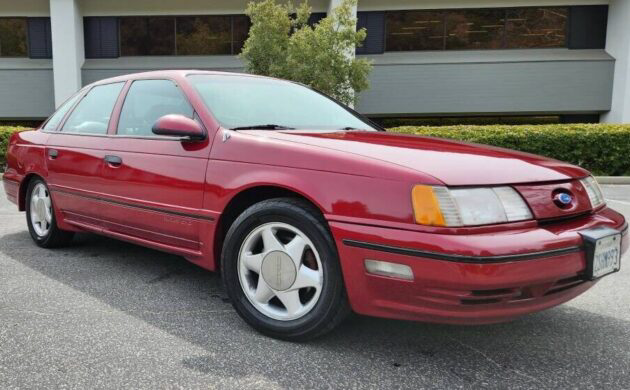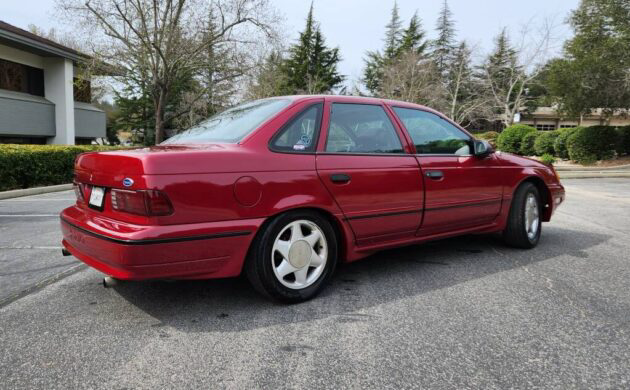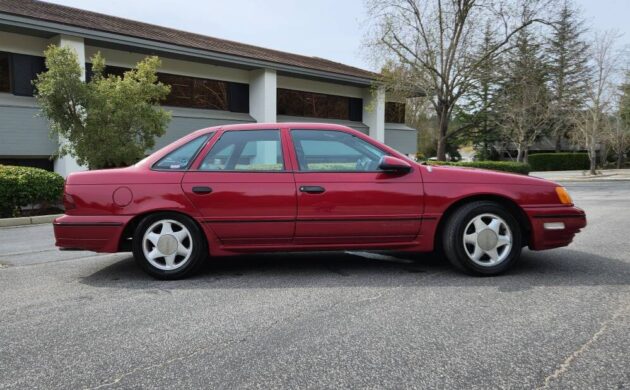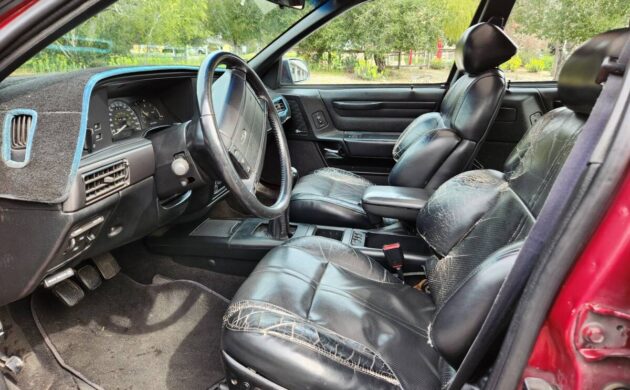Assuming such a number could be calculated, I’d expect a vast majority of 1980s and (at least early-) 1990s mid-size family sedans met their demise in a scrapyard. I can confirm that all 2 of my family’s mid-size sedans from this era — a 1984 Buick Century and a 1986 Oldsmobile Delta 88 — did, in fact, retire to a scrapyard. Thankfully some devoted caretakers have saved some of the good ones from suffering such a fate, like this 1990 Ford Taurus SHO I found here on Craigslist in Scotts Valley, California for $4,000.
An all-new model for 1986, the Ford Taurus helped push car design in a more aerodynamic direction and shook off some of that malaise-era feel. The Ford Taurus SHO (Super High Output) kept that ball rolling when it debuted for the 1989 model year with significant performance improvements over its lower-trim siblings. SHO production was strong out of the gate for the 1989 model year, with 15,519 built. This 1990 example is from the second-lowest production year when just 8,325 were built.
The original buyer of this Taurus opted for the least chosen exterior color in 1990 – Electric Red Clearcoat Metallic. It did receive a repaint about 7 years ago, which the seller says “looks great and turns heads.” I love the look of the 16” SHO wheels – and someone please correct me if I’m wrong – but I believe these were only original to the second-generation (1992-1995) Taurus SHO. I’d install a set of the original 15” wheels and be pretty pleased with how this one looks.
The interior appears to be the weakest point here. The 33-year-old black leather is showing wear, the carpets are faded, and the carpeted dash cover is presumably hiding some cracks. The front buckets look oh so 90s-y but also like they’d hold you tight. The backseat is in a little better shape.
The SHO was the sprightliest of Taurus trim levels in 1990. A 3.0L Yamaha-built V6 sent power to the front wheels with a 5-speed manual transmission. The SHO had significantly stronger performance numbers than its lower trim counterparts, with a 0-60MPH run in 6.7 seconds and a quarter-mile pass taking 15.1 seconds on its way to a top speed of 143MPH. One of those devoted caretakers I mentioned earlier has completed some work in the past 12k miles – water pump and timing belt, full front suspension rebuild, as well as new brakes and tires, however, the seller notes a valve cover leak.
At just $4k, this could prove to be a good entry into the collector car market. The seller feels the same: “This is a great driver quality classic that you could use every day and still stand out in on the weekends.”








Not doing too bad for 232,000 miles…or so…no wonder the innards look tired.
Probably one of the best V6 engines ever made. Definitely an equal to the Ferrari and Busso V6 engines. A popular upgrade was an under drive crank pulley to raise the rev limiter. My friend owned several and spent time drag racing them. I always looked at these cars as an engine searching for a fantastic chassis to be installed into. The Yamaha V8 in the later SHO series was also a delight.
I wonder at what point the engine would need a complete rebuild – top and bottom ends? Nice overall presentation for >200k mi.
Right after the new owner starts beating on it. If it’s got 200k on it, it’s been babied. Cars get used to how they’re treated.
V8 SHO is a nightmare.
I had one almost exactly like this.
The power was amazing, and handling was good, although it had significant torque steer
The major problem with mine was simply the quality of construction. The fittings that held the bumper covers to the body were crap and failed.
What Ford calls “leather” most people called dodge shoes, and the bolsters were very poorly fastened to the seat backs.
You want to make sure that oil changes have been frequent and regular. Mine had “issues” because the previous owner had not paid attention to this, and flecks of solid oil nearly trashed, the engine due to narrow oil passages in the block.
I had a 92 SHO 5-speed manual, it was an entertaining car. Like alphasud said, great engine. This one has very high mileage but has had some mechanical and cosmetic work (paint). The inside is very tired. But for someone with not much money to spend who wanted a car which would be fun to thrash around, this fits the bill.
My buddy dragged one in his 5L 1989.. Some tire spin at the start,
then a lazy 1-2 shift and the Taurus went screaming by us.
Wonder how the clutch is??
My brother got a new job as a traveling salesman, I believe it was late in 1988. He got to order a new company car and he requested a Taurus. Some how, he finagled an SHO. I think it was right before Christmas when it arrived. Anyway, he had probably the first one in our area. I was with him when he drove into the Ford stealership, backed into a parking stall. As expected, the sales staff noticed it and started coming out to see it. He wanted to show it off, (sorry), and revved it up, side-stepped the clutch tool off hard. He was a very aggressive driver, actually a bit of a jerk, and had to downshift and fly by anyone that happened to get in front of him. That car was very fast over 60, when it really started to breath. We were in the Chicago area when he passed another driver and we were doing about 140 mph. Looking back, I’m surprised that he survived the whole experience. I read somewhere that the engine could spin up to 8.5K rpm but that it was limited to 7200 rpm because of the air conditioner. It was real sleeper back in 1989.The best part was, he didn’t have to pay for it!
This was my car. The dash is not cracked and the car lived
in the garage for most of the 20 years or so I owned it.
The license plate even has my iniitials on them!
Held up well and looks good..
When the SHO came out in ’89 Car & Driver put it on their cover and the feature article lead was “the fastest 4 door you can buy under $50,000”.
A poke at BMW.
I still have a copy of that issue and in ’95 bought a red ’91 and joined the Atlanta based SHO Club. We rented the motorcycle track at Taledega and took turns around that winding and very unforgiving road course. The first and best thing I did was put actual, true dual exhaust on it and woke it way way up – spun to 7,000 rpms freely after that and was the ideal motor for all those twisty turns and 100+ mph on the back straightaway .
These early SHOs warped rotors easily and cable linkage as well were upgraded by Ford on later models.
The SHO, at $20k new, did a lot of things really well while competing with the SC T Bird and Fox body 5.0 Mustang, in house.
This SHO is worth a 2nd look.
GLWTS!
Never had one but always wanted one but it had to have a 5 speed. When they finally were able to mate a strong enough automatic trans to handle that Yamaha motor, Ford was able to sell more. However (to me) the auto version was just another American sedan. The stick makes it a worthwhile car and not just another old clunker. Great motor!!!
I ended having bad luck with my Ford performance-built vehicles.
I had an XR4Ti that ate through manual transmissions and a ’91 SHO that spent too much time in the shop having expensive parts replaced. Both were a hoot to drive, and I wasn’t hard on either one. Just bad luck I guess.
It did drive me away from Ford for awhile, but now there are 3 of them parked in the driveway.
Some go???? Clearly the author never drove one with 3 foot pedals.
V8 SHO is a nightmare.
Not if you weld the cans like so many of us did.
A customer managed to get one of these as a company car. When he burned the clutch out, he tried to blame it on a lot jockey who had driven it maybe 100 feet. It was about to go to litigation when an admin assistant told the fleet manager about how she always smelled burning clutch in the parking garage after he’d driven up the exit ramp. His was the only manual tranny company car. I think he got a Tempo on the next cycle.
I’m interested in learning more about Taurus SHO’s, as they have such a mixed reputation. I’ve always been fascinated about the specs and the possibility that the cars would be fun to drive, but I’ve also read that that cars consistently had significant reliability problems.
Rtdreep: They are nice cars and the general consensus is that people had good luck with them. I bought mine when it was a little over 1 year old and had 12K miles on it if I recall correctly. That is considered relatively new, but I don’t know how the previous owner treated it during those first 12K, they might have beat the living hell out of it. I bought it from a Ford dealership that I personally knew the owner, so I’m sure he wouldn’t have sold me a lemon if he knew about it.
Mine always drove fine, it’s just the little niggling issues that gave me a bad experience. The speedometer never read correctly, especially when it was cold – something the dealer could never fix. The starter went, the fan motor went – these are items that left me stranded. One time in a really really bad part of town. Lucky I found a local shop and the guy did a good job of fixing it. Everything that went bad was at least $300 just for the part because they were all hi-po special parts.
My job had me on the road back then, so a reliable car was super important. I traded it for a new Maxima on lease and that car had zero issues for the 3 years I owned it.
So, I really enjoyed the SHO and glad that I had the chance to enjoy it. Right now, I’m not sure how great of a buy they are considering all of the specialty parts that went into building them.
I had a 1991 SHO Plus (which was an end of the first generation Taurus package with the plastic “power bulge” hood and other trim). I basically gave it to my son and he still has it and drives it with 180K miles on the clock. The “slicer” rims on this Craigs List car came from a later model SHO (2nd generation 1992-1995) as you can see with the center caps embossed with the SHO name. These rims were made in Italy and were stock on only the 1991 SHO with a blank center cap. The biggest issue with these cars is going to be finding parts for them. They do require A LOT of maintenance, especially important is the 60K service due EVERY 60,000 miles where valves have to be shimmed, water pump should be replaced along with all drive belts, etc. They are a blast to drive and are becoming very rare and collectible at the same time. We bought another 1991 SHO two years ago with just under 100K on the odometer and have to spend quite a bit putting it back into tip-top shape. $4,000 for this listed car is only the beginning if you’re serious about keeping it maintained. It might be worth it in the long run, but that may still be a few years off.
I’ll add a comment to PRA4SNW and David White’s responses. I would say their comments are very accurate, based on what I read and what I experienced. I had mine until only 52K miles and did have several issues. But in my case almost none of them were SHO-specific. In other words they were parts/issues which were common to the regular Taurus.
Owned all 3 generations of the FWD SHO’s. White 1990, Red 1995 and Black 97 and the 90 and 95 were both five speeds. The 97 of course was an automatic. I really can’t say which one I’d rather have back over the other. Each one had different characteristics that made them what they were. The 90 was the squared off muscle sedan, the 95 was the more modern high tech sedan over the 90 and the 97 was the high revving V8 kinda oddball looking sedan that u could stomp the gas not have to worry about shifting gears pushing in the clutch youd just stomp,steer and go !!!
Might be an unpopular opinion but I care more about the regular sedan and wagons than the SHOs. As someone who is trying to find a first model year 1986 Ford Taurus LX station wagon in medium canyon red to restore one day, I’m constantly finding the Gen 1 SHOs and far fewer sedan and wagons for sale. It gets boring to me and frustrating that I’m only finding those SHOs. Only 8,000 SHOs made in 1990 and that’s easier to find that the regular Taurus and Sable sedans and wagons that had a production number of over 2.5 million. Not a good sign…